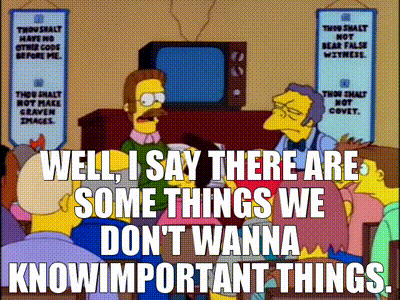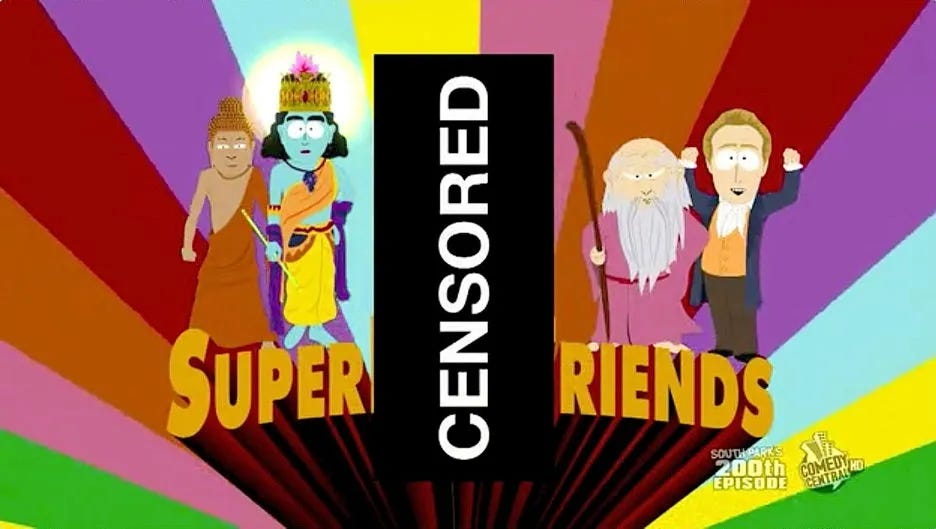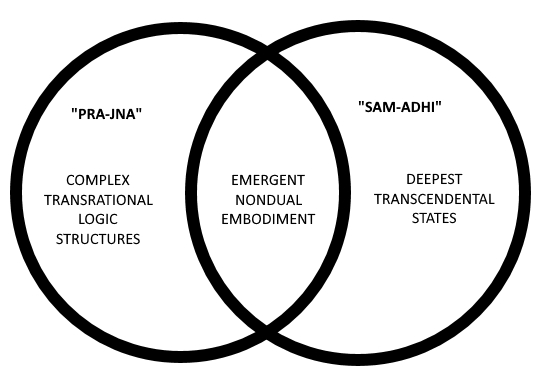UN/SPEAKABLE: Effing the Ineffable
Historical & Contemporary Pathways Toward Disambiguation of Trans-Symbolic States
Q: Do you over-intellectualize nonduality?
Yes.
Absolutely (sic).
Let me explain why…
1. A SINGLE BLADE OF GRASS
There are phenomena that people describe as indescribable.
Certain states of consciousness are so exquisitely different from our conventional narrative/symbolic psychology that they seem antithetical to the very spirit of rational representation. Accessing and stabilizing these states may even require that you proactively prevent your attention from slipping back into the seductive thrall of socialized language, differentiation & identity.
What’s more, there also seems to be a very particular mode of consciousness that is traditionally described as being different from all differences. It is specifically a mode of participation that is pointed out by symbolically cancelling everything else.
It is Absolute (as opposed to all the partial things).
It is Empty (compared to all the substances).
It is Unity (compared to the multitude).
It is Eternal (compared to the changing).
It is Self-existent (compared to everything that has a cause).
We speak it by contrasting it against every other speakable or thinkable thing. In a sense, its proper name is the Indescribable or Unspeakable. That is roughly accurate description of its peculiar characteristic.
Humans, historically, have been pretty comfortable describing the Ultimate as a mystery that cannot be spoken. To name it, we suspect, is to miss it. The reality of ultimate conditions and their correlated modes of consciousness are simple too vast, endless, complex and transrational to be adequately captured in a linguistic symbol.
Okay. But this also applies to a single blade of grass.
I.e. this problem is not specific to the “Ultimate Condition.” Any ordinary phenomenon is always more than its name. The fullness of each thing exceeds its word, symbol, picture or story. It does not matter if it is a blade of grass, donut, nipple, democracy or the electron. Every ordinary thing is more than can be said. Yet somehow that does not stop us from using words to describe them quite effectively.
The word “fish” does not keep anyone from fishing. And a few hundred years ago we decided that some fish should be called “mammals.” The obvious gap between reality and representation does not mean we cannot use words effectively. Nor does it suggest that we abandon attempts to improve our words.
Yet some folks still get edgy and suspicious when you speak about the Unspeakable Reality. Especially if you propose to say it “better.”
“Whereof one cannot speak, thereof one must be silent,” said Wittgenstein. Yet it seems that we are somewhat selective in our logophobia. There are some impossible-to-say things we don’t mind talking about and others that we try to put off-limits to speech. We do not mind the “left brain” trying to articulate numbers, news stories and architectural plans but many of us balk when it tries to probe into God, Love or the Meaning of Life. We want to place those honred nouns into the special post-narrative space. Why? Is it possible to critique this as somewhat biased, hypocritical or a bit fragile? Perhaps.
My guess is that we are confused about what we mean by “unspeakable…”
2. DISAMBIGUATING THE INDESCRIBABLE
The concept of the unspeakable has at least two distinct meanings:
One is that people feel that a certain concept is intolerably obnoxious. Merely mentioning it draws it too near to our emotional life. The symbol points toward a reality that seems far too salacious, immoral, dangerous, traumatic or unconventional for average folks to tolerate.
When I hint (devilishly) about the various unspeakable things I did to (and/or with) your sister last night, it seems as though such speech profanes something very sacred. The reality they suggest is so disruptive that we do not even tolerate the symbol of that reality. Indescribable = unbearable.
The other meaning is that the phenomenon is objectively too much for thoughts and speech to grasp. So complex that it cannot be meaningfully compressed into patterns that human minds can productively track. So alien to the evolved limitations of a survival-oriented terrestrial mammal that it does not even effectively register in our perspectival and cognitive systems. Indescribable = irreducible.
The first category, accordingly to popular opinion, might be probed with enough daring, but the second category is implicitly informationally opaque. It is too alien. In fact, merely by using recognizable human symbols to describe such phenomena, we might be misleading ourselves into fantasies that take the place of reality. Describing it moves us farther from the truth of the phenomenon. Our only hope, therefore, is to do sensemaking via some non-symbolic methods of direct engagement.
This is a famously seductive idea.
3. THE HORRORS OF THE POST-FRACTAL AGE
The great American 1940s amateur pulp fiction writer H. P. Lovecraft popularized the notion of transdimensional horrors that exceed the meagre modernist grasp of rationality & sanity. Fun. His monsters could only be described as indescribably horrible! That is a very juicy and playful way of writing. It constantly arouses the sense of an additional power of ultra-reality lurking just beyond our symbols. Yet anyone who has tried to draw, paint or film a Lovecraft story runs into the same pernicious problem: How do we actually depict an impossible being?
Typically, four strategies of depiction are used.
(1) We conceal the phenomenon itself and instead simply show the humans gazing at it — pupils dilated, eyebrows raised, slack jawed, losing their minds.
(2) We half-show it by placing it in shadows or arranging the scene so that the phenomenon partly vanishes beyond some particular threshold.
3) We could — as our ancestors often did — use hybrids. Synthetic and reconfigured creatures like the sphinx, chimera or basilisk often imply a mythic realm of forms that eludes our habitual categorizations.
(4) We could use patterns from nature that are socially felt to be antagonistic to the left-brain habits of linear representation. Ooze, tentacles, transformation, multi-directionality, cellular weirdness, icthyomorphic (fishy) adaptations, excessive speed, vast scale— in order to evoke an uncanny effect upon civilized humans.
The problem with all these entertaining solutions is that they actually still remain accessible to the reasoned gaze of the civilized human being. We create and recognize these forms. They are not indescrible. They exist within the realm of representation. There is a technology for the uncanny and the apparently boundless. This has been especially obvious since the 20th-century breakthroughs in chaos science, complexity, emergence, catastrophe, fractals, nonlinear algorithms, irreducible computation, etc.
Every single day, our species gets better at clarifying the sensible architecture of phenomena that were previously described as “impossible to rationally describe.” Patterns that strike our human senses and human hearts as disordered or magically ordered are in fact very ordered, predictable and technically useful — even when they blow our minds.
There is apparently no special limit beyond which we can “never” get better at articulating any condition of reality. So perhaps we should reconsider what we have previously dismissed as unspeakable?
Perhaps even those rare ineffable phenomena that have been proposed as profoundly divine, nondual, transcendent, epiphanic, beatific (otherwise enacted specifically through a practice that brackets conventional mental contents and categories) might somehow be described more productively?
(NOTE: The argument so far is that people are careless with the notion of the indescribable. They do not distinguish between unbearable sensations and objectively irreducible complexity. Nor have they assimilated the fact that complex, alien and mind-bending patterns are rationally describable. We can get better at describing them by updating our inherited modes of speech and thought. In principle, it might even be possible to upgrade the way we talk and think about special conditions of reality and/or consciousness that mystics conventionally refer to as ineffable.)
4. PAGING DR. NAGARJUNA MOBIUS !
The famous Mobius strip was discovered (mathematically) in 1958 by August Ferdinand Mobius. It rationally, coherently and symbolically describes a situation in which the outside and inside both are & are not different. That seems important. Nondual-ish.
If you follow a straight line along the surface of this special twisted object you will always be separate from the “other side” and yet you will traverse the entire surface as a single continuity. It is both one AND two. It is separate AND non-separate. Every part is both inside and outside and yet is obviously not impossible to describe. It is not even a paradox. It logically makes complete sense — it just feels weird.
Approximately 2000 years ago, a Buddhist saint named Lord Whitesnake (Sri Nagarjuna) demonstrated something similar. He used complex logical formulations of verbal thought to describe and induce the odd feels of trans-binary states of consciousness.
Popular legend has it that Lord Whitesnake was the intermediary descendant between the Buddha and Zen. In a famous scene on Vulture’s Peak, Gotama the Awakened (buddha) transmitted a special teaching to his disciple Great Turtle (maha-kasyapa). This unique lineage passed the extraordinary transmission down through the generations to Lord Whitesnake whose dharma descendant Lord Wisdom-Awakener (bodhi-dharma) carried it to China where it flourishes as Chan Buddhism (called “zen” in Nippon).
So we can, in part, look to the work of Lord Whitesnake as a fundamental source for the style of communication that became common among the high adepts of ancient Zen. Particularly the oddly shaped Koans which are logically structured, verbal and symbolic communications of the indescribable. These structures may have their origin in earlier insights about the potential to establish complex transcendental relationships between profound consciousness & certain arrangements of speech/thought.
Lord Whitesnake’s approach to nonduality is demonstrated by what scholars call the tetralemma — his fourfold logic. In order to describe situations, conditions and phenomena (in a way that articulates that facet of their being which we previously simplified as “indescribable”) we must use a dynamic arrangement of claims that moves our attention repeatedly into spaces between standard epistemological categories. Not altogether different that they types of mathematical statements needed to give us Mobius-like patterns).
He says:
Anything is the opposite of its opposite. It also cannot be limited to being the opposite of its opposite. Nor can it be understood merely as “neither opposite of its opposite nor NOT the opposite of its opposite.” Nor can it be understood only as both those things.
Or:
You cannot say it is THIS not THAT.
You cannot say it is not THIS but actually THAT.
You cannot say it is both THIS and THAT.
You cannot say it is neither THIS nor THAT.
The lazy thing to do — common in many spiritual communities — is to take all this as authoritative proof that speech and thinking are inherently flawed and ultimately inconsequential. Because the “true state” is ultimately the unthinking background of consciousness, we, therefore, are justified in not doing any deeper thinking or getting any better at articulating things that matter to us.
Sad.
It misses a whole dimension of what Lord Whitesnake is doing with this collection of interactive meta-propositions. Basically, what it leaves out is the movement of attention through the set of perspectives. Our participatory cognition does not encounter them as static omnipresent facts but rather we pass from one to another — transgressing, again and again, the four modes of epistemological capture.
We are led to persistently re-encounter the logic of the simultaneously boundaried and unboundaried nature of logical distinctions. It is a meta-logic of differences not an assertion of the Undifferentiated against the Differences.
This is very much how the mathematical description of a Mobius is structured. The algorithm moves forward from one dual/singular boundary condition to another — tracing a representation that has the qualities that previously seemed to escape or be opposed to conventional depictions.
When, centuries later, his Hui-Neng (the ruralist-iconoclastic “6th Chan Patriarch”) described — in the illustrious Platform Sutra — that samadhi is prajna & prajna is samadhi, he was following very definitely in the stream of Lord Whitesnake.
We can get better (as Nagarjuna and Mobius showed) at articulating the structures that might otherwise be described as ineffably superlative mysteries that exceed all descriptions. We may need complexity, dynamism, ratios, paradoxes, overlaps, processes and folds to do it — but that’s okay. That gets us a lot further than merely SAYING that it cannot be said…
5. THE LANGUAGES OF STATES
What in the hell are we talking about?
Exactly.
We act like we know what our words mean — but that’s debatable. Just get into a discussion about “God” or “the Left” and you’ll quickly run into intense sensemaking turbulence because, it turns out, people mean many different things with those apparently shared words. Sometimes they mean totally opposite things. It therefore becomes essential (unless you merely wish to perversely enjoy a pointless argument!) to describe rather than label our ideas. That is a step forward in languaging.
Here’s an example:
Terry O’Fallon has a pretty good model of psychological development which includes a range of levels called “subtle.” These are people who do not experience themselves merely as bodies-in-the-world-of-objects but as self-reflective agents who can modify their own ideas and feelings. Possessors of an ongoing abstract selfhood that relates to their organism. That’s perfectly fine but it is not what I mean by the word “subtle.”
So I’ll have to describe what I mean. I am pointing toward a range of states (and perhaps realms) that are present at all times for all beings. A fundamental dimension of ontology that is reflected in certain evolved, neurologically-mediated forms of consciousness.
Why do I mention this?
Well, the classic (oversimplified) description of consciousness in Vedic, Theosophical and Integral circles tends to group it into four general clusters. Each can be probed more deeply, and rationally inspected, through a different typical mode of language:
adverbs, adjectives and modes
nouns and verbs
apophatics & maximals
incorporative trans-oppositionals
Subtle. Gross. (Self-)causal. Nondual.
Although we started with “subtle” as an example, the thrust of this essay obviously concerns the latter two states. And my point will be that common discourse and even great mystics fail to differentiate between at least these two forms of indescribable consciousness because a more nuanced descriptive language is often missing.
So consider these two categories of the transrational:
Causal mysticism involves states that correspond to a descriptive grammar involving tautological (indefinitely self-causing), apophatic (description by cancellation) & maximal (excessive evaluation) terminology.
Examples include: oneness, emptiness, dreamless sleep, eternity, pure consciousness, the absolute, nonbinary awareness, infinity, zero & unconditional, deepest, highest, supreme, only, unity. These words are almost “syntactical” in the sense that they point toward conditions that are more like logical operators than concrete and subtle objects. A pure universal witness consciousness is (very much like an “equals sign”) described as nonlocal, priorly assumed, transparent, sizeless & endlessly available.
Nondual mysticism, on the other hand, is specifically described by terminology that is paradoxical, adjacent, incorporative & trans-binary. It is for this reason that the term non/dual is used in contrast to a term like oneness.
Examples: both/and, in-between, also, is/n’t, neti neti, self-other, in/finite, post-absolute, many-one, being-becoming & im/possible
Whereas “causal states” involve a boundary that cancels all boundaries, a “nondual state” involves a transfiguration of the meaning of boundaries. Their specifically limiting characteristic is removed.
In casual states, there is a significant difference between the thoughtless and endless balance point of all beings and becomings. In nondual states, this difference is also insignificant.
Thinking and trying to experimentally articulate these phenomena in the langauge of boundaries may prove useful. Such langauge has made enormous progress in areas of physics, mathematics and philosphy. For example, what does a dynamic fractal pattern show us about how we should think about boundaries?
How should apply the logic of boundaries to transcedental states of consciousness IF the actual nature of boundaries is not like a “wall” but more like the fluid edges in an endless fractal zoom?
So we can see that certain linguistic lenses may have the potential to move our description of extraordinary states forward by adding degrees of distinction that parallel other contemporary improvements in our capacity for mapping and description.
To pursue such explorations we must actually access these states, of course, but we must also arrangement thought and speech patterns in ways that might complexly correlate more aptly to the mirco-phenomenology of those states.
And some basic differentiations might be necessary within matters that have often been treated as homogenously indescribable.
Some conditions, for example, are conventionally described as indescribable because they point to a degree of necessity and omnipresence that exceeds the typical objects of cognition. While other conditions are called indescribable because they require us to tolerate paradoxical sensations involved in the simultaneous affirmation & negation of basic logical pairs within a more complex dynamic field of forms.
Causal mysticism is unspeakable.
Nondual mysticism is un/speakable.
I have spoken?






